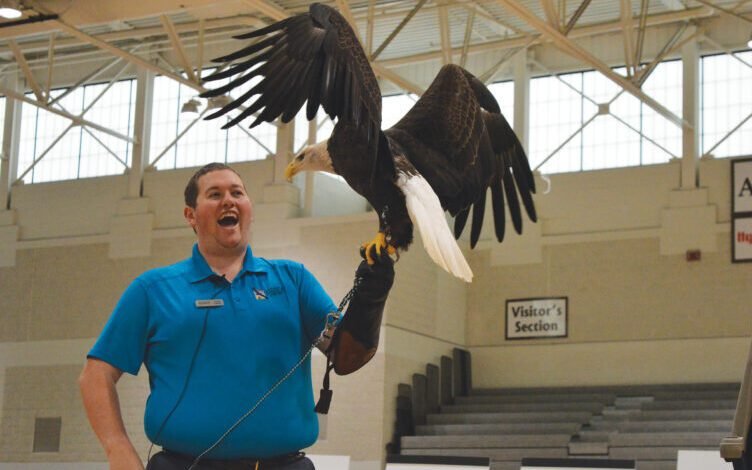Science in action | News, sports, jobs


Photo by Deb Gau Jarod Lueck, educator at the National Eagle Center in Wabasha, introduces Latsch the bald eagle to the audience of more than 700 students.
MARSHALL — The crowd gathered at Southwest Minnesota State University on Tuesday was quiet as they waited to be introduced to a special guest.
Jarod Lueck, an educator at the National Eagle Center in Wabasha, opened an animal transporter and brought in Latsch, an 8-year-old bald eagle.
While Latsch stretched his wings, Lueck answered questions about eagles from schoolchildren.
“How fast can he fly?” one student asked.
Bald eagles can fly at speeds exceeding 25 miles per hour, Lueck said — but when they dive, they can reach speeds of 100 miles per hour.
The National Eagle Center visit was the keynote presentation at this year’s Science and Nature Conference, hosted by the Southwest West Central Service Cooperative. More than 700 area students, grades K-8, came to SMSU for a day of science-related activities. Topics ranged from engineering to learning about animals and the environment.
During his presentation, Lueck told students about the tools eagles use to capture their prey. Bald eagles are equipped with strong beaks and talons to grab prey like fish.
“What are your other tools?” Lueck asked.
“Their eyes,” replied a student in the crowd.
Lueck said an eagle’s keen vision is crucial to hunting. When Latsch was found near Winona, he was blind in one eye, Lueck said. Although this meant Latsch couldn’t survive in the wild, he could be an eagle ambassador.
Later in the conference, students were able to attend hands-on classes on everything from robotics to botany. In a classroom, presenter Sam Jens taught students how they could make their own helicopters. The children began by cutting and folding paper into shapes that rotated as they fell through the air.
“He flew!” said one student, after throwing the paper helicopter into the air and making it spin.
Next, the class went on to build helicopters that used rubber bands to turn the helicopter’s blades.
In another session, secondary school students accepted an engineering challenge: they had 20 minutes to try to build the tallest tower with plastic straws and duct tape.
Milroy students Addy Brey and Maddox Eliason started by gluing together a long line of straws to add height.
“Ours would definitely not win for the strongest” Eliasson said. After a while, the tower began to collapse and Brey and Eliason bent more straw into an arch to support the base of the tower.
Many group towers had to change their design mid-challenge to keep them from falling over.
“We’re doing a freestyle,” said Murray County Central student Paige Schuur.
As the group grew its tower, members added their own ideas.
“It’s leaning – we need some support right here,” said MCC student Colton Joens.
Organizers said this year the Science and Nature Conference was celebrating its 30th anniversary. The event has grown a lot over time, said Andrea Anderson, SWWC student enrichment coordinator.
“It started as a Saturday event,” she said.
When SWWC started holding the conference on a weekday, participation really soared. Before the COVID pandemic, the conference was beginning to see more than 1,000 students attend each year.
This year, a total of 731 students participated in the conference.
“We are starting to recover our numbers” Anderson said.




